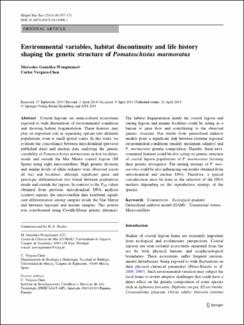| dc.contributor.author | González-Wangüemert, Mercedes | |
| dc.contributor.author | Vergara-Chen, Carlos | |
| dc.date.accessioned | 2018-03-20T14:19:36Z | |
| dc.date.accessioned | 2018-03-20T14:19:36Z | |
| dc.date.available | 2018-03-20T14:19:36Z | |
| dc.date.available | 2018-03-20T14:19:36Z | |
| dc.date.issued | 2014-04-24 | |
| dc.date.issued | 2014-04-24 | |
| dc.identifier | https://hmr.biomedcentral.com/articles/10.1007/s10152-014-0396-1 | |
| dc.identifier.issn | 1438-387X | |
| dc.identifier.uri | http://ridda2.utp.ac.pa/handle/123456789/4437 | |
| dc.identifier.uri | http://ridda2.utp.ac.pa/handle/123456789/4437 | |
| dc.description | Coastal lagoons are semi-isolated ecosystems exposed to wide fluctuations of environmental conditions and showing habitat fragmentation. These features may play an important role in separating species into different populations, even at small spatial scales. In this study, we evaluate the concordance between mitochondrial (previous published data) and nuclear data analyzing the genetic variability of Pomatoschistus marmoratus in five localities, inside and outside the Mar Menor coastal lagoon (SE Spain) using eight microsatellites. High genetic diversity and similar levels of allele richness were observed across all loci and localities, although significant genic and genotypic differentiation was found between populations inside and outside the lagoon. In contrast to the F ST values obtained from previous mitochondrial DNA analyses (control region), the microsatellite data exhibited significant differentiation among samples inside the Mar Menor and between lagoonal and marine samples. This pattern was corroborated using Cavalli-Sforza genetic distances. The habitat fragmentation inside the coastal lagoon and among lagoon and marine localities could be acting as a barrier to gene flow and contributing to the observed genetic structure. Our results from generalized additive models point a significant link between extreme lagoonal environmental conditions (mainly maximum salinity) and P. marmoratus genetic composition. Thereby, these environmental features could be also acting on genetic structure of coastal lagoon populations of P. marmoratus favoring their genetic divergence. The mating strategy of P. marmoratus could be also influencing our results obtained from mitochondrial and nuclear DNA. Therefore, a special consideration must be done in the selection of the DNA markers depending on the reproductive strategy of the species. | en_US |
| dc.description.abstract | Coastal lagoons are semi-isolated ecosystems exposed to wide fluctuations of environmental conditions and showing habitat fragmentation. These features may play an important role in separating species into different populations, even at small spatial scales. In this study, we evaluate the concordance between mitochondrial (previous published data) and nuclear data analyzing the genetic variability of Pomatoschistus marmoratus in five localities, inside and outside the Mar Menor coastal lagoon (SE Spain) using eight microsatellites. High genetic diversity and similar levels of allele richness were observed across all loci and localities, although significant genic and genotypic differentiation was found between populations inside and outside the lagoon. In contrast to the F ST values obtained from previous mitochondrial DNA analyses (control region), the microsatellite data exhibited significant differentiation among samples inside the Mar Menor and between lagoonal and marine samples. This pattern was corroborated using Cavalli-Sforza genetic distances. The habitat fragmentation inside the coastal lagoon and among lagoon and marine localities could be acting as a barrier to gene flow and contributing to the observed genetic structure. Our results from generalized additive models point a significant link between extreme lagoonal environmental conditions (mainly maximum salinity) and P. marmoratus genetic composition. Thereby, these environmental features could be also acting on genetic structure of coastal lagoon populations of P. marmoratus favoring their genetic divergence. The mating strategy of P. marmoratus could be also influencing our results obtained from mitochondrial and nuclear DNA. Therefore, a special consideration must be done in the selection of the DNA markers depending on the reproductive strategy of the species. | en_US |
| dc.language | eng | |
| dc.language.iso | eng | en_US |
| dc.rights | https://creativecommons.org/licenses/by-nc-sa/4.0/ | |
| dc.rights | info:eu-repo/semantics/openAccess | |
| dc.subject | Microsatellites | en_US |
| dc.subject | Transitional waters | en_US |
| dc.subject | Generalized additive model (GAM) | en_US |
| dc.subject | Ecological gradient | en_US |
| dc.subject | Connectivity | en_US |
| dc.subject | Microsatellites | |
| dc.subject | Transitional waters | |
| dc.subject | Generalized additive model (GAM) | |
| dc.subject | Ecological gradient | |
| dc.subject | Connectivity | |
| dc.title | Environmental variables, habitat discontinuity and life history shaping the genetic structure of Pomatoschistus marmoratus | en_US |
| dc.type | info:eu-repo/semantics/article | |
| dc.type | info:eu-repo/semantics/publishedVersion | |
